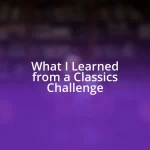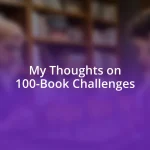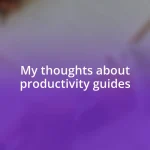Key takeaways:
- Biographies offer insights into the human experience, evoking emotions and inspiring personal reflection on resilience and change.
- Researching historical context enriches our understanding of significant figures and their contributions, revealing the complexities behind their achievements.
- Sharing insights from biographies fosters connection and prompts discussions about personal values, encouraging individuals to reflect on their impact and aspirations.
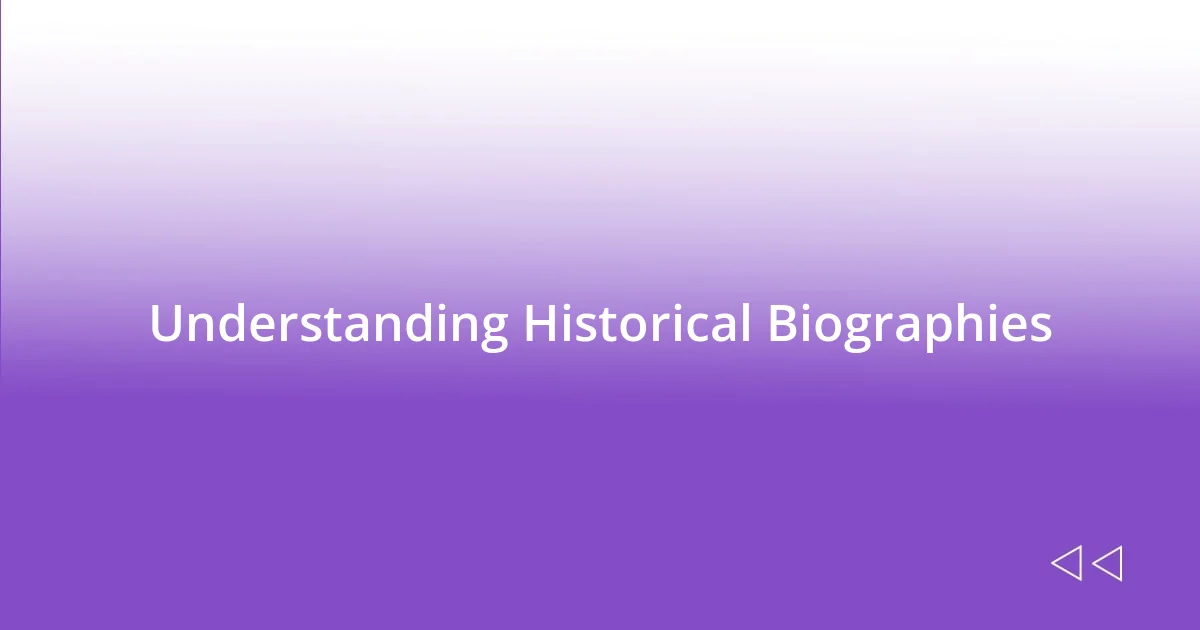
Understanding Historical Biographies
Understanding historical biographies is about more than just dates and events; it’s about connecting with the lives of individuals who have shaped our world. I remember the first time I read about a historical figure who overcame incredible odds. It felt like uncovering a hidden treasure—each page revealed not just facts, but the raw human experience behind those achievements.
It’s fascinating to see how these biographies capture the emotions and motivations of their subjects, often evoking a range of feelings in us as readers. For instance, I found myself both inspired and heartbroken reading about someone who faced adversity head-on yet still felt the weight of solitude. How can one person’s triumph resonate so deeply within us, triggering our own reflections on resilience?
These narratives give context to history, allowing us to empathize with those who walked before us. Have you ever paused to consider how your perspective might shift when you see history through the eyes of another? It’s like stepping into their shoes for a moment, making their struggles and victories all the more vivid and relatable. This dimension adds depth to our understanding, transforming mere facts into lessons that echo through time.
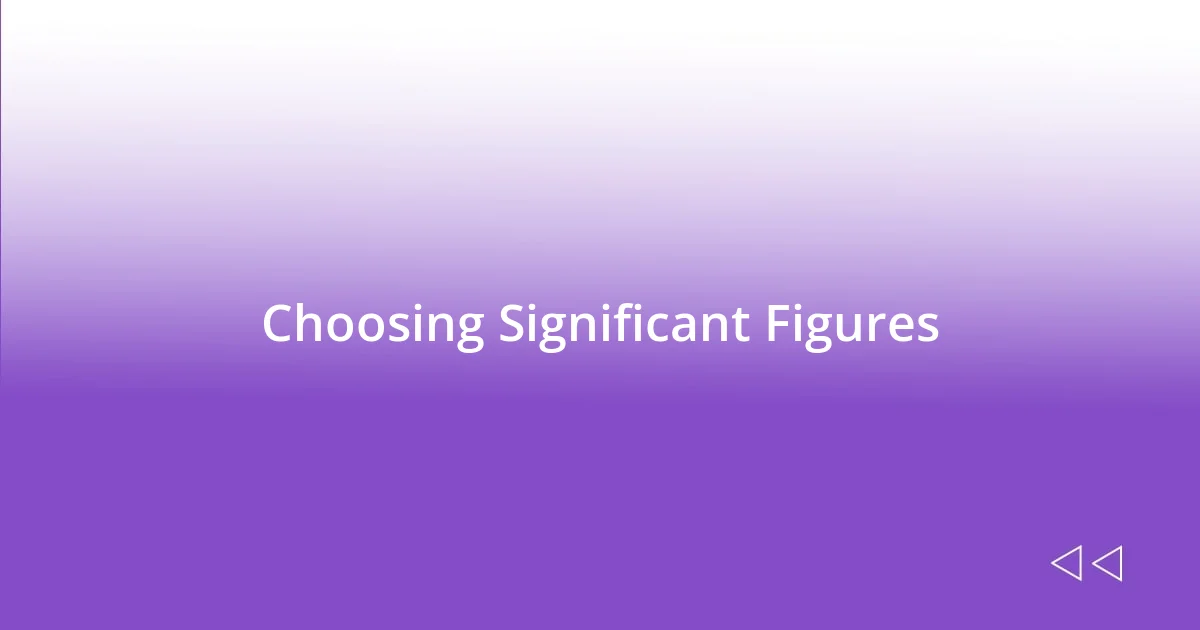
Choosing Significant Figures
When choosing significant figures in historical biographies, it helps to reflect on those individuals who embody the struggles and triumphs that resonate with us. I remember when I encountered the biography of a lesser-known activist whose tireless work often goes unrecognized. Learning about their unwavering commitment sparked a sense of motivation in me—not just to honor their legacy but to seek out my own passions that could contribute to change. It’s remarkable how focusing on these figures can reshape our understanding of history.
- Look for figures whose stories evoke strong emotions.
- Consider individuals whose lives mirror contemporary challenges.
- Seek out diverse voices often overlooked in mainstream narratives.
- Reflect on personal connections you might have with their experiences.
- Think about what lessons their journeys can teach us today.
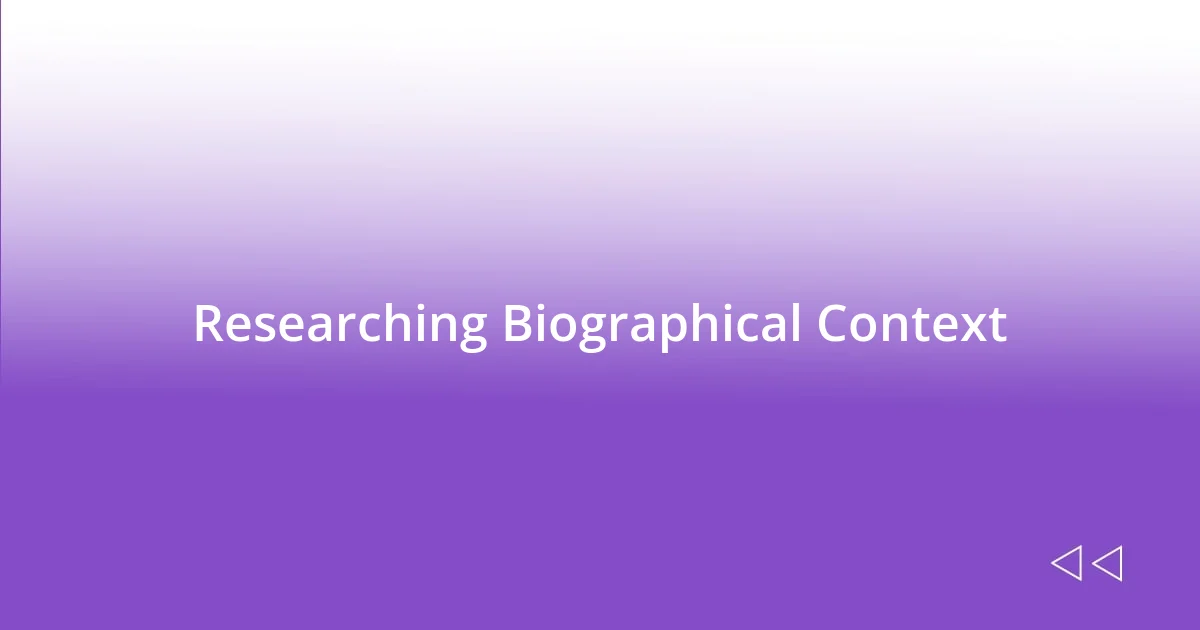
Researching Biographical Context
Researching the context behind historical biographies truly enriches our understanding of the figures we read about. I once dove deep into the life of Marie Curie and found that her groundbreaking work went hand-in-hand with the societal challenges of her time, particularly the hurdles faced by women in science. Connecting her achievements to the broader context of gender inequality in the early 20th century made her story resonate even more deeply with me—it was as if I could feel her determination against all odds coursing through the pages.
As I sifted through various sources, I discovered how cultural and political landscapes shape the narratives we encounter. A biography of Nelson Mandela revealed not just his imprisonment but also the intricate dynamics of apartheid and global solidarity movements. Can you imagine how these layers of context turned his struggle into a universal story of liberation? It reminded me that biographies aren’t isolated tales; they’re interwoven with the fabric of their time, inviting us to explore the complexities involved in historical events.
Taking the time to understand the time period surrounding a figure helps illuminate not just what they did but why they did it. For instance, while reading about Frida Kahlo, I learned about the tumultuous political situations in Mexico and how her art reflected not just personal pain but also cultural identity. This research added a richness to her story, allowing me to appreciate her work on a much deeper level. How do you think understanding the backdrop of a figure’s life influences your perception of their achievements?
| Element | Importance |
|---|---|
| Historical Events | Provides context for the biography’s narrative. |
| Cultural Background | Helps understand the societal influences on the individual. |
| Personal Challenges | Highlights the adversities faced and their significance. |
| Contemporaneous Figures | Allows for comparison and contrast with other historical figures. |
| Legacy Understanding | Gives insight into how the figure’s life impacted future generations. |

Analyzing Biographical Narratives
Analyzing biographical narratives offers a unique lens through which we can interpret not just the lives of remarkable individuals, but also the broader societal currents that shape them. I recall reading about Winston Churchill during his most challenging days in World War II. It struck me how his speeches reflected not just his determination but also the collective spirit of a nation in turmoil. How can we overlook the emotional weight these narratives carry? Each story is a tapestry woven from personal and historical threads, inviting us to grasp the lived experiences behind the facts.
It’s fascinating to dissect the layers within a biographical narrative, especially when considering the contrasts in a person’s life. For example, I was intrigued by the duality in the life of Helen Keller. Her story is one of overcoming immense physical barriers, yet it’s her fierce advocacy for social justice that truly embodies her spirit. Reflecting on how her personal challenges align with her societal impact made me ask, “What drives someone to fight for others once they’ve achieved their own triumphs?” The answers lie in the connections we see between personal persistence and public activism.
In the end, I believe the heart of biographical analysis lies in reliving these journeys, not just as spectators but as participants in the ongoing narrative of humanity. Each figure we study offers us insights into resilience, hope, and the complex relationships between individual choices and societal changes. The struggles and triumphs they faced prompt us to consider our own paths: How do our challenges shape our contributions to the world? As we engage with these narratives, we’re reminded that history isn’t just about the past; it’s an invitation to shape our future.
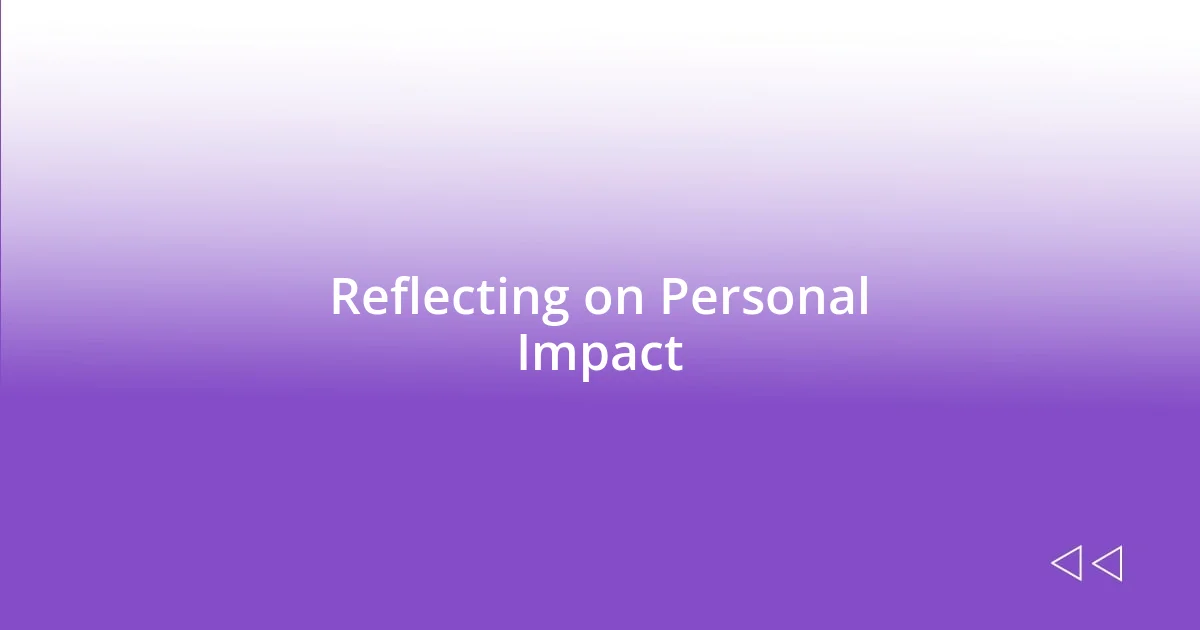
Reflecting on Personal Impact
Reflecting on personal impact is often an emotional journey. I remember the first time I read about Rosa Parks—her quiet strength during a pivotal moment in the Civil Rights Movement struck me deeply. I found myself asking, “What would it take to stand up against injustice when the world seems aligned against you?” Recognizing her courage in that moment encouraged me to consider how my own actions, however small, could contribute to positive change, fostering a sense of empowerment I hadn’t felt before.
As I continued to explore these biographies, I often thought about the personal sacrifices these figures made for their causes. The story of Mahatma Gandhi, for example, revealed how deeply his commitment to nonviolence came from his own life experiences of discrimination and injustice. Understanding his motivations allowed me to empathize with his struggles. I began to wonder, “What personal experiences in my life motivate me to advocate for my beliefs?” This reflection made me realize that our journeys are often mirrored in the lives of those who came before us.
In many ways, engaging with these narratives has become a mirror for my own life. They prompt me to consider my legacy and the impact I’m leaving behind. I remember pondering how historical figures faced moments of doubt yet still pressed on. It made me reflect on my challenges and think, “Am I honoring the lessons learned from those who paved the way?” This contemplation deepens my connection with the past, urging me to harness that same resilience in my everyday life.
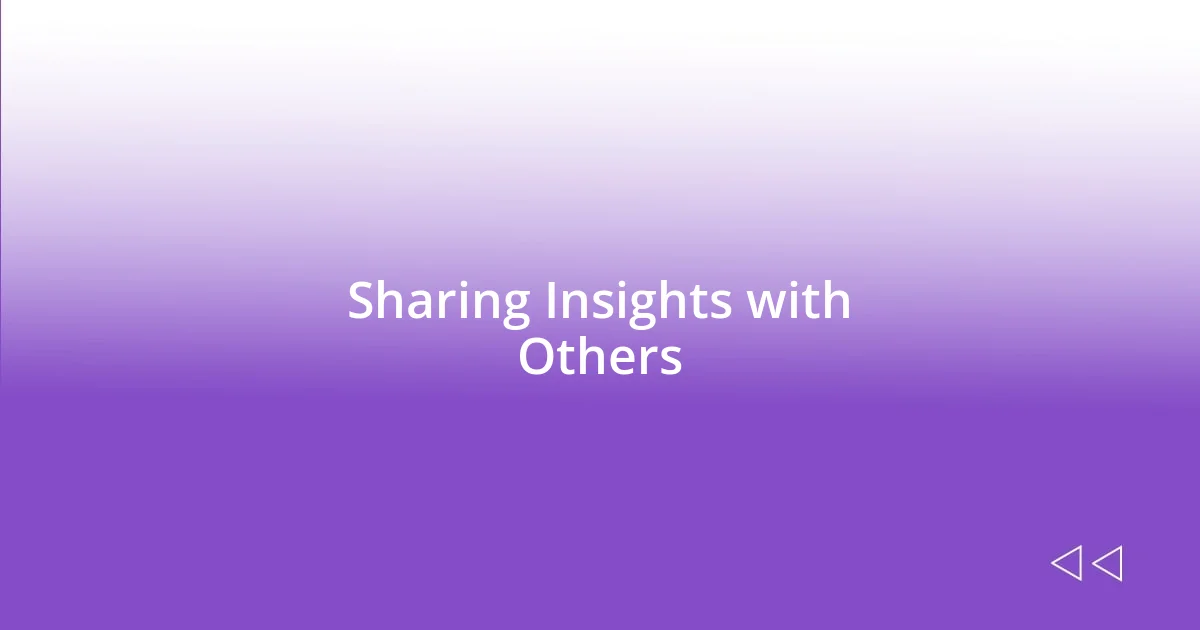
Sharing Insights with Others
Sharing insights with others is a powerful tool for connection. I remember hosting a book club discussion after diving into the life of Anne Frank. As I shared my thoughts on her courage and hope, I could see the impact on the group. It sparked deeper conversations about resilience in the face of adversity. Isn’t it fascinating how one story can resonate so profoundly and bring people together?
When I participate in discussions around historical figures, I often find unexpected insights emerge. Recently, I was talking about Nelson Mandela’s life with a friend, and we both reflected on how his forgiveness shaped South Africa’s transition. This led us to ask ourselves: how can we practice forgiveness in our own lives? It’s a reminder that these narratives don’t just stay in history; they ripple through our daily choices and relationships.
I’ve found that sharing these insights can elevate our understanding of both the past and ourselves. One evening, while discussing the bravery of Malala Yousafzai, I felt a surge of motivation. Her story impelled me to think about my role as an advocate for education. It made me wonder: what steps am I taking in my life to champion causes that matter to me? Opening up about these reflections with others creates a shared space for growth and inspiration, showing that we’re all part of a larger narrative.
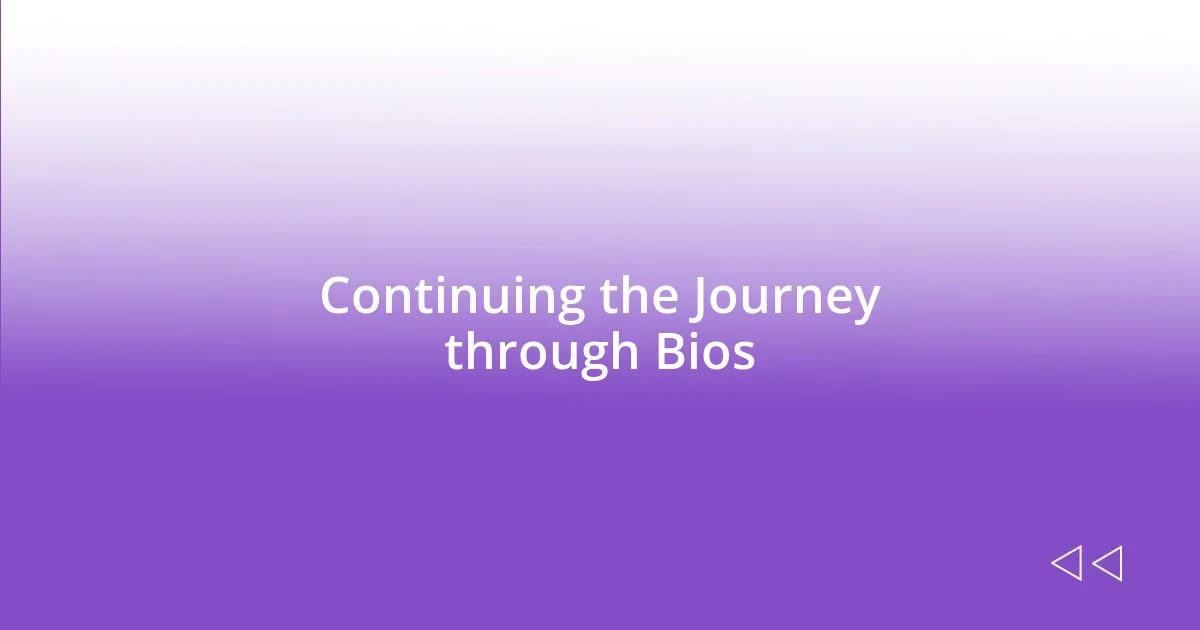
Continuing the Journey through Bios
Continuing the journey through biographies can be transformative. I recall a rainy afternoon when I stumbled upon the autobiography of Frederick Douglass. His journey from slavery to becoming a powerful advocate for abolition sparkled with tenacity. In that moment, I couldn’t help but ask myself, “What barriers am I letting hold me back?” Douglass’s indomitable spirit became a catalyst for my own aspirations, making me realize how crucial it is to confront the obstacles I face in my own life, no matter how daunting they may seem.
As I delved deeper into the lives of figures like Albert Einstein, it became clear to me that curiosity often fuels greatness. I was particularly drawn to how his unconventional thinking challenged societal norms. I found myself pondering, “How often do I challenge my own assumptions?” This introspection opened a door for me to embrace my curiosity and seek knowledge beyond the surface. Einstein’s story inspired me to create space in my life for experimentation and open-mindedness.
What I increasingly love about exploring these lives is the realization that their struggles mirror our own, often spotlighting the tiny victories we can achieve every day. For instance, reading about the artistic journey of Frida Kahlo made me reflect on my own creative endeavors. I asked myself, “What unique experiences shape my perspective?” Engaging with her work not only renewed my passion for my art but also reinforced the message that it’s okay to draw inspiration from our pain and triumphs. Such personal connections fuel my journey and remind me that every biography read is a step forward in understanding not just them, but also myself.


